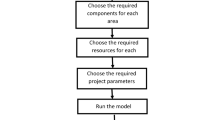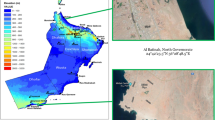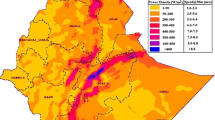Abstract
The present study was conducted with the objective of evaluating several proposed turbines from 25 kW to 1.65 MW in order to select the appropriate turbine for electricity and hydrogen production in Firuzkuh area using the decision making trial and evaluation (DEMATEL) and data envelopment analysis (DEA) methods. Initially, five important factors in selection of the best wind turbine for wind farm construction were determined using the DEMATEL technique. Then, technical-economic feasibility was performed for each of the eight proposed turbines using the HOMER software, and the performance score for each proposed wind turbine was obtained. The results show that the GE 1.5sl model wind turbine is suitable for wind farm construction. The turbine can generate 5515.325 MW of electricity annually, which is equivalent to $ 1103065. The average annual hydrogen production would be 1014 kg for Firuzkuh by using the GE 1.5sl model turbine.
Similar content being viewed by others
References
Mostafaeipour A, Jadidi M, Mohammadi K, Sedaghat A. An analysis of wind energy potential and economic evaluation in Zahedan, Iran. Renewable & Sustainable Energy Reviews, 2014, 30: 641–650
Mostafaeipour A. Economic evaluation of small wind turbine utilization in Kerman, Iran. Energy Conversion and Management, 2013, 73: 214–225
Mostafaeipour A, Sedaghat A, Ghalishooyan M, Dinpashoh Y, Mirhosseini M, Sefid M, Pour-Rezaei M. Evaluation of wind energy potential as a power generation source for electricity production in Binalood, Iran. Renewable Energy, 2013, 52: 222–229
Montoya F, Manzano-Agugliaro F, Lopez-Marquez S, Hernandez-Escobedo Q, Gil C. Wind turbine selection for wind farm layout using multi-objective evolutionary algorithms. Expert Systems with Applications, 2014, 41(15): 6585–6595
Chowdhury S, Zhang J, Messac A, Castillo L. Optimizing the arrangement and the selection of turbines for wind farms subject to varying wind conditions. Renewable Energy, 2013, 52: 273–282
Ritter M, Deckert L. Site assessment, turbine selection, and local feed-in tariffs through the wind energy index. Applied Energy, 2017, 185: 1087–1099
Perkin S, Garrett D, Jensson P. Optimal wind turbine selection methodology: a case-study for Burfell, Iceland. Renewable Energy, 2015, 75: 165–172
Hammad M, Batarseh L. Innovative wind turbine selection method using modified Weibull probability function. Journal of Architectural Engineering Technology, 2015, 4(1): 139
Salem A A. Turbine selection for wind farm potentials in east Libya. Dissertation for the Master’s Degree. Indonesian: University of Sebelas Maret, 2015
Park C Y, Lee T H, Dorris S E, Balachandran U. Hydrogen production from fossil and renewable sources using an oxygen transport membrane. International Journal of Hydrogen Energy, 2010, 35(9): 4103–4110
Ehteshami S M M, Vignesh S, Rasheed R K A, Chan S H. Numerical investigations on ethanol electrolysis for production of pure hydrogen from renewable sources. Applied Energy, 2016, 170: 388–393
Bakenne A, Nuttall W, Kazantzis N. Sankey-Diagram-based insights into the hydrogen economy of today. International Journal of Hydrogen Energy, 2016, 41(19): 7744–7753
Cherry R S. A hydrogen utopia? International Journal of Hydrogen Energy, 2004, 29(2): 125–129
Giraldi M R, François J L, Martin-Del-Campo C. Life cycle assessment of hydrogen production from a high temperature electrolysis process coupled to a high temperature gas nuclear reactor. International Journal of Hydrogen Energy, 2015, 40(10): 4019–4033
Badwal S P S, Giddey S, Munnings C. Hydrogen production via solid electrolytic routes. Wiley Interdisciplinary Reviews. Energy and Environment, 2013, 2(5): 473–487
Olateju B, Monds J, Kumar A. Large scale hydrogen production from wind energy for the upgrading of bitumen from oil sands. Applied Energy, 2014, 118: 48–56
Patyk A, Bachmann T M, Brisse A. Life cycle assessment of H2 generation with high temperature electrolysis. International Journal of Hydrogen Energy, 2013, 38(10): 3865–3880
Siyal S H, Mentis D, Mörtberg U, Samo S R, Howells M. A preliminary assessment of wind generated hydrogen production potential to reduce the gasoline fuel used in road transport sector of Sweden. International Journal of Hydrogen Energy, 2015, 40(20): 6501–6511
Giddey S, Kulkarni A, Badwal S P S. Low emission hydrogen generation through carbon assisted electrolysis. International Journal of Hydrogen Energy, 2015, 40(1): 70–74
Suleman F, Dincer I, Agelin-Chaab M. Comparative impact assessment study of various hydrogen production methods in terms of emissions. International Journal of Hydrogen Energy, 2016, 41(19): 8364–8375
Huang P H, Kuo J K, Wu Z D. Applying small wind turbines and a photovoltaic system to facilitate electrolysis hydrogen production. International Journal of Hydrogen Energy, 2016, 41(20): 8514–8524
Mostafaeipour A, Khayyami M, Sedaghat A, Mohammadi K, Shamshirband S, Sehati M A, Gorakifard E. Evaluating the wind energy potential for hydrogen production: a case study. International Journal of Hydrogen Energy, 2016, 41(15): 6200–6210
Sigal A, Cioccale M, Rodríguez C R, Leiva E P M. Study of the natural resource and economic feasibility of the production and delivery of wind hydrogen in the province of Córdoba, Argentina. International Journal of Hydrogen Energy, 2015, 40(13): 4413–4425
Loisel R, Baranger L, Chemouri N, Spinu S, Pardo S. Economic evaluation of hybrid off-shore wind power and hydrogen storage system. International Journal of Hydrogen Energy, 2015, 40(21): 6727–6739
Mostafaeipour A, Abesi S. Wind turbine productivity and development in Iran. In: 1st International Conference on Biosciences, BioSciencesWorld 2010. Cancun, Mexico, 2010, 112–118
Mostafaeipour A, Bardel B, Mohammadi K, Sedaghat A, Dinpashoh Y. Economic evaluation for cooling and ventilation of medicine storage warehouses utilizing wind catchers. Renewable & Sustainable Energy Reviews, 2014, 38: 12–19
Mostafaeipour A, Qolipour M, Mohammadi K. Evaluation of installing photovoltaic plants using a hybrid approach for Khuzestan province, Iran. Renewable & Sustainable Energy Reviews, 2016, 60: 60–74
Alavi O, Sedaghat A, Mostafaeipour A. Sensitivity analysis of different wind speed distribution models with actual and truncated wind data: a case study for Kerman, Iran. Energy Conversion and Management, 2016, 120: 51–61
Alavi O, Mohammadi K, Mostafaeipour A. Evaluating the suitability of wind speed probability distribution models: a case of study of east and southeast parts of Iran. Energy Conversion and Management, 2016, 119: 101–108
Qolipour M, Mostafaeipour A, Shamshirband S, Alavi O, Goudarzi H, Petković D. Evaluation of wind power generation potential using a three hybrid approach for households in Ardebil Province, Iran. Energy Conversion and Management, 2016, 118: 295–305
Büyüközkan G, Çifçi G. A novel hybrid MCDM approach based on fuzzy DEMATEL, fuzzy ANP and fuzzy TOPSIS to evaluate green suppliers. Expert Systems with Applications, 2012, 39(3): 3000–3011
Hsu C W, Kuo T C, Chen S H, Hu A H. Using DEMATEL to develop a carbon management model of supplier selection in green supply chain management. Journal of Cleaner Production, 2013, 56: 164–172
Ou Yang Y P, Shieh H M, Tzeng G H. A VIKOR technique based on DEMATEL and ANP for information security risk control assessment. Information Sciences, 2013, 232: 482–500
Bai C, Sarkis J. A grey-based DEMATEL model for evaluating business process management critical success factors. International Journal of Production Economics, 2013, 146(1): 281–292
Baykasoğlu A, Kaplanoglu V, Durmuşoglu Z, Şahin C. Integrating fuzzy DEMATEL and fuzzy hierarchical TOPSIS methods for truck selection. Expert Systems with Applications, 2013, 40(3): 899–907
Lee H S, Tzeng G H, Yeih W, Wang Y J, Yang S C. Revised DEMATEL: resolving the infeasibility of DEMATEL. Applied Mathematical Modelling, 2013, 37(10–11): 6746–6757
Carrillo M, Jorge J M. A multiobjective DEA approach to ranking alternatives. Expert Systems with Applications, 2016, 50: 130–139
Boloori F. A slack based network DEA model for generalized structures: an axiomatic approach. Computers & Industrial Engineering, 2016, 95: 83–96
Wanke P, Barros C P, Nwaogbe O R. Assessing productive efficiency in Nigerian airports using Fuzzy-DEA. Transport Policy, 2016, 49: 9–19
Toloo M. On finding the most BCC-efficient DMU: a new integrated MIP-DEA model. Applied Mathematical Modelling, 2012, 36(11): 5515–5520
Toloo M, Nalchigar S. A new integrated DEA model for finding most BCC-efficient DMU. Applied Mathematical Modelling, 2009, 33(1): 597–604
Rödder W, Reucher E. Advanced X-efficiencies for CCR- and BCCmodels—towards Peer-based DEA controlling. European Journal of Operational Research, 2012, 219(2): 467–476
Govindan K, Khodaverdi R, Vafadarnikjoo A. A grey DEMATEL approach to develop third-party logistics provider selection criteria. Industrial Management and Data Systems, 2016, 116(4): 690–722
Author information
Authors and Affiliations
Corresponding author
Rights and permissions
About this article
Cite this article
Mostafaeipour, A., Qolipour, M. & Goudarzi, H. Feasibility of using wind turbines for renewable hydrogen production in Firuzkuh, Iran. Front. Energy 13, 494–505 (2019). https://doi.org/10.1007/s11708-018-0534-6
Received:
Accepted:
Published:
Issue Date:
DOI: https://doi.org/10.1007/s11708-018-0534-6




